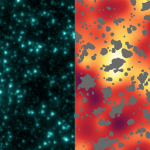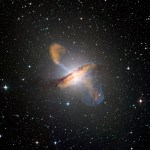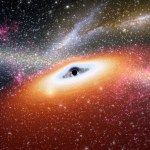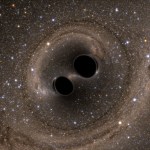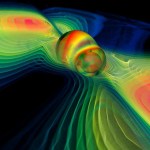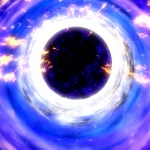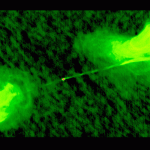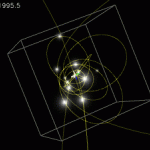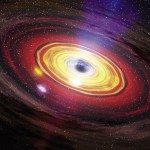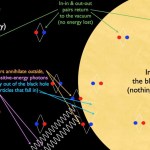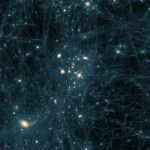Black Holes
"That what wrong with the media today. All they have is questions, questions, questions. They never have cookies." -Cookie Monster
There are lots of things to worry about in this Universe, including falling into a black hole. But unless you happen to fall directly into the event horizon, an incredibly small region of space for most black holes, you very likely won't be swallowed at all!
This artist’s rendering shows a galaxy being cleared of interstellar gas, the building blocks of new stars. Image credit: ESA/ATG Medialab.
Sure, you might be torn apart, accelerated, ionized, and spit back…
"Not only does God play dice, but... he sometimes throws them where they cannot be seen." -Stephen Hawking
The New York Times ran an article on Stephen Hawking promising there was a possible escape route from a black hole, after all. In the text, Hawking asserts,
"They are not the eternal prisons they were once thought. If you feel you are trapped in a black hole, don’t give up. There is a way out."
While it might appear that matter escapes a black hole, this is only from matter well outside of the event horizon at all times. Image credit: ESO/MPE/Marc Schartmann.
But what the actual…
"What's really exciting is what comes next. I think we're opening a window on the universe -- a window of gravitational wave astronomy." -Dave Reitze
On September 14, 2015, LIGO directly detected gravitational waves for the first time, from the inspiral-and-merger of two quite massive black holes. Despite the fact that no electromagnetic radiation signal was expected, the Fermi GBM instrument measured a high-energy X-ray event just 0.4 seconds after LIGO’s 200 millisecond detection occurred. According to NASA scientists working on the Fermi mission, there was just a 0.2% chance of a false…
“[The black hole] teaches us that space can be crumpled like a piece of paper into an infinitesimal dot, that time can be extinguished like a blown-out flame, and that the laws of physics that we regard as ‘sacred,’ as immutable, are anything but.” -John Wheeler
Dark matter is one of the biggest mysteries in the Universe. We can feel its gravitation, we can see its effects on galaxies, clusters and the large-scale structure of the Universe. But when it comes to very small scales, we haven't been able to detect dark matter, either directly or indirectly, leading us to wonder at what it's…
“If I can't make it through one door, I'll go through another door - or I'll make a door. Something terrific will come no matter how dark the present.” -Rabindranath Tagore
Time continues marching on here at Starts With A Bang, just as it does everywhere. My Patreon supporters have stepped up their game, and we're just $21 shy of unlocking our next goal! There are two great new items this week I'd love to share with you: first, our newest Podcast on dark energy and the fate of the Universe,
and second, a video whose script I helped write (with a bonus coming up) for…
“A single day is enough to make us a little larger or, another time, a little smaller.” -Paul Klee
When it comes to normal matter, dark matter is a bit of a puzzle. Other than through the gravitational force, there's no way we've yet figured out to make it interact. Try and collide it with matter and it passes right through; try and bombard it with energetic particles or radiation and it's completely transparent. But the story is quite different when it comes to dark matter and black holes.
A black hole feeding off of an accretion disk. Image credit: Mark Garlick (University of Warwick).…
"When I was in high school, I was certain that being an astronaut was my goal. It was a very important time -- Sally Ride was making her first flight into space and she had a real impact on me. Those 'firsts' kind of stick in your head and really become inspirations for you." Karen Nyberg, astronaut
On September 14th, less than 72 hours after being activated at its highest sensitivity ever, the Laser Interferometer Gravitational wave Observatory (LIGO) detected its first unambiguous signal in both detectors, a signal that corresponded to the merger of two massive black holes: 36 and 29…
In a validation of Albert Einstein's genius, the power of new technology, and the relevance of the scientific method (even if it takes a century), scientists working on a project called LIGO have witnessed ripples in the fabric of spacetime caused by gravitational waves. First predicted by Einstein in 1916 on the basis of general relativity, gravitational waves are cosmic shock waves that can result from the interactions of massive objects like black holes and neutron stars. Unlike electromagnetic waves, which pass through space, gravitational waves change the shape of space itself. Extremely…
"Even if the Fermi detection is a false alarm, future LIGO events should be monitored for accompanying light irrespective of whether they originate from black hole mergers. Nature can always surprise us." -Avi Loeb
Ever since LIGO first announced the direct detection of gravitational waves from two merging black holes, the physics and astronomy community has been struggling to understand an unexpected phenomenon that appears to have come along with it: a short-period gamma ray burst.
An artist’s impression of two stars orbiting each other and progressing (from left to right) to merger with…
"Maybe that is our mistake: maybe there are no particle positions and velocities, but only waves. It is just that we try to fit the waves to our preconceived ideas of positions and velocities. The resulting mismatch is the cause of the apparent unpredictability." -Stephen Hawking
Black holes are the densest, most compact objects in the Universe, with anywhere from a few to many billions of solar masses of material concentrated into a singularity. At a certain distance away from that singularity, every black hole has an event horizon: a region of space from within which nothing can escape, not…
"Twinkle, twinkle quasi-star.
Biggest puzzle from afar.
How unlike the other ones.
Brighter than a billion suns.
Twinkle, twinkle, quasi-star.
How I wonder what you are." -George Gamow
One of the most interesting classes of objects in the entire sky is one that's invisible to the naked eye, yet appears brighter than anything else in radio wavelengths: the quasar. Originally coined as an acronym (QSRS) for Quasi-Stellar Radio Source, these were later determined to be incredibly energetic sources of accelerated matter powered by a supermassive black hole.
Image credit: Aurore Simonnet, NASA /…
"Never look down to test the ground before taking your next step; only he who keeps his eye fixed on the far horizon will find the right road." -Dag Hammarskjold
One of the great discoveries of the past few decades was that of a supermassive black hole at the center of our Milky Way. No longer was it mere conjecture or unverified theory; observations in the X-ray, infrared, radio, and of stars orbiting a central, non-luminous point all indicate the presence of a 4 million solar mass black hole at a location known as Sagittarius A*.
Image credit: X-ray: NASA/UMass/D.Wang et al., IR: NASA/…
"It's not the job of the theorist to defend his model at all costs!" - Joel Primack
One of the more puzzling phenomena in our quantum Universe is that of entanglement: two particles remain in mutually indeterminate states until one is measured, and then the other — even if it's across the Universe — is immediately known.
Image credit: Ulf Leonhardt.
In theory, this should be true even if one member of the pair falls into a black hole, although it's impossible to measure that. However, we can (and have) measured that for the laboratory analogue of black holes, known as "dumb holes," and the…
We live in a Universe full of galaxies, supermassive black holes, and violence. The violence is particularly relevant here, because every so often, these galaxies merge, and if they each contain a supermassive black hole, the gravitational wave "ripples" that get sent through space will literally shake and affect everything that's in them.
Image credit: NASA, ESA, the Hubble Heritage Team (STScI/AURA)-ESA/Hubble Collaboration and A. Evans (University of Virginia, Charlottesville/NRAO/Stony Brook University), K. Noll (STScI), and J. Westphal (Caltech).
If you had a perfect clock --…
100 years ago, Einstein put forth his General Theory of Relativity, and 99 years ago, Karl Schwarzschild came up with the mathematical solution describing a black hole, a solution we now know is not only physically valid, but one that has many examples all across the Universe.
Image credit: NASA / Dana Berry / Skyworks Digital.
Yet when you consider quantum physics, the matter gets complicated: while you ought to be able to run the laws of physics the same forwards and backwards, a black hole seems to wind up in an irreversibly different state, in the end, from what you started with.…
“I was strongly encouraged by a science teacher who took an interest in me and presented me with a key to the laboratory to allow me to work whenever I wanted.” -Frederick Reines, discoverer of the first neutrino
That kind of education is irreplaceable, and at Starts With A Bang we do our best to bring the stories, knowledge and wonder of the Universe to everyone. Here's a look back at what we hit on this past week:
Have we solved the black hole information paradox? (for Ask Ethan),
The ultimate superhero cake (for our Weekend Diversion),
See inside the swirling storms of…
“Thus it seems Einstein was doubly wrong when he said, God does not play dice. Not only does God definitely play dice, but He sometimes confuses us by throwing them where they can’t be seen.” -Stephen Hawking
You've no doubt heard that Stephen Hawking is claiming that the black hole information paradox has now been resolved, with the information encoded on the event horizon and then onto the outgoing radiation via a new mechanism that he'll detail in a paper due out next month, along with collaborators Malcom Perry and Andrew Strominger.
Image credit: TU Wien.
Only, that's not really what'…
Earlier this week, Stephen Hawking shook up the world when he announced that he had uncovered the solution to the black hole information paradox at a conference in Stockholm. When particles fall into (or create) a black hole, information is encoded on the black hole's surface, but when the black hole decays into radiation, that information appears to be lost, as the radiation is thermal.
Image credit: E. Siegel.
But perhaps the information is stored on the event horizon, and can be encoded into the outgoing radiation thanks to the interplay of gravitation and matter. Details should be…
“All enterprises that are entered into with indiscreet zeal may be pursued with great vigor at first, but are sure to collapse in the end.” -Tacitus
If you want to form a structure like a planet, star or black hole, you need a large amount of mass together in one place. The way to bring that mass together, of course, is through the force of gravity, which attracts everything with mass towards one another in this Universe.
Image credit: ESO/VPHAS+ team, via http://www.eso.org/public/images/eso1403a/.
So why, then, would the greatest source of mass in the Universe -- dark matter -- be…
There's something puzzling about black holes, if you stop to consider it. On the one hand, they're objects so massive and dense -- compacted into such a small region of space -- that nothing can escape from it, not even light. That's the definition of a black hole, and why "black" is in the name.
Image credit: James Provost, sciencenews.org.
But gravity also moves at the speed of light, and yet the gravitational influence of a black hole has absolutely no problem extending not only beyond the event horizon, but infinite distances out into the abyss of space.
Image credit: Henze, NASA.…



